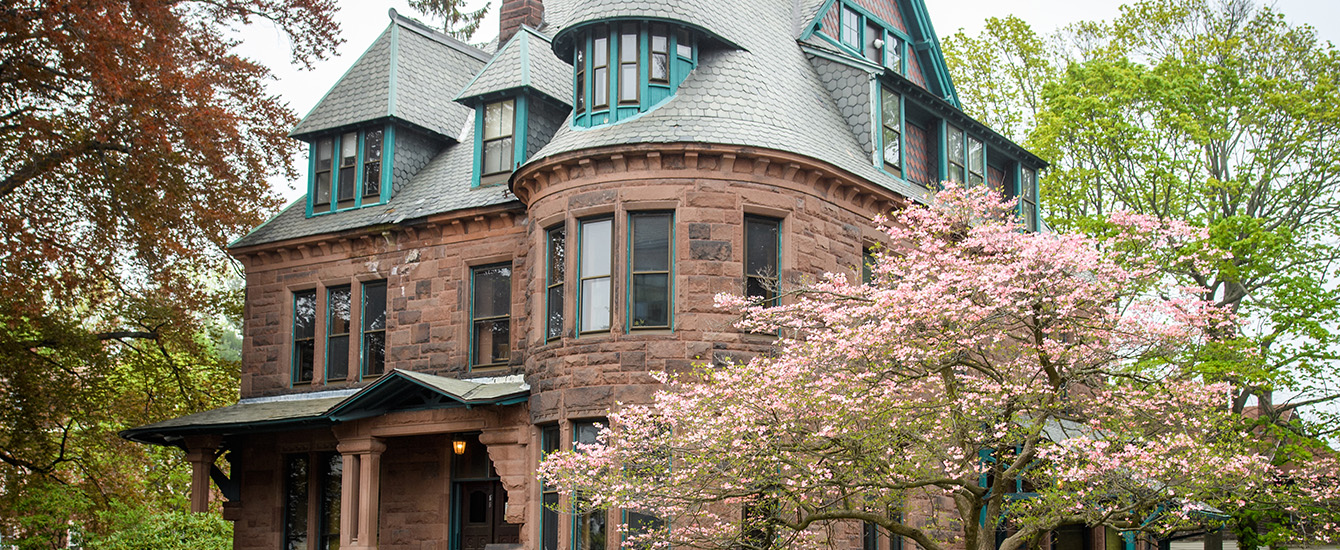Completed by 1878, the Norcross homes, built by two brothers, James A. (1831-1903) and Orlando W. (1839-1920) Norcross, are arguably the earliest and finest examples of Queen Anne style architecture in Worcester, Massachusetts. The buildings are notable for their architectural style, interior appointments, and historic associations.
The Norcross family originated in Maine and moved to Salem, Massachusetts, in 1843. After the Civil War, James and Orlando established their own general contracting business on Cape Anne. When the firm was engaged in 1868 to build the Worcester High School (now obliterated), the Norcross brothers transferred their base to Worcester where it remained for the rest of their careers. The successful completion of the Worcester High School linked the Norcross brothers into a profitable and nearly continuous association with the building’s architect, H.H. Richardson, arguably the most influential architect of the late nineteenth century.
They proceeded to craft most of Richardson’s major commissions, and their firm became the construction giant of the late nineteenth and early twentieth centuries. Trinity Church (Boston), the New York Public Library, Allegheny County Court House and Jail (Pittsburgh), the Rhode Island State House, Symphony Hall (Boston), South Station (Boston), St. John’s Episcopal Church (New York), Marshall Field’s (Chicago), and a renovation of the White House are among their more notable commissions. In Worcester, City Hall, the Slater Building, the State Mutual Building (340 Main St.), the Clark University Library (now the Jefferson Academic Center), and many others bore the Norcross imprint. Noted for their quality masonry craftsmanship, fiscal integrity, and organizational innovation, James and Orlando Norcross made important contributions to the architectural and commercial history of their era both independently and through their association with H.H. Richardson and the Romanesque Revival style that their masonry construction techniques helped to make possible.
The two homes at the corner of Claremont and Woodland Streets are near mirror images of each other. Both buildings are of rock-faced sandstone quarried in East Longmeadow, Mass. Each building rises two-and-one-half stories to a dormered attic and presents an asymmetrical facade to the world. The main entry is in the center of the south façade, with a rounded, dormered turret-bay on one side and an expanse of triple windows on the other. A side entrance on each building abuts a single story rounded bay that extends the dining room. A carriage house, originally positioned between the two houses and shared by the brothers, has been removed. The only significant exterior elements in which the two buildings differ are: (1) the extension of the front porch on the Orlando Norcross house (16 Claremont) to form a porte cochere, complete with mounting platform; (2) the existence of a small projecting wooden alcove varying the otherwise flat north façade of 16 Claremont; and (3) the survival of original French cut slates on the main roof and bichromatic slates on the dormers of the James Norcross House.
In their internal ornamentation, the two buildings exhibit greater individuality, although the basic organization of the two structures is similar. The two houses were richly and diversely ornamented. Lavish use of wood paneling characterizes the public space of both houses, with the James Norcross house using lighter oak paneling, arranged in geometric patterns in its main staircase, than the Orlando Norcross house. 18 Claremont is also characterized by lincrusta wallpaper, a heavy wallcovering that simulates the texture of embossed leather, whereas 16 Claremont possesses a finely wrought split landing ornamented with two spiral shaped Romanesque columns in wood.
A succession of post-Norcross owners made considerable modifications to the buildings’ internal spaces. These included a nursing home, a convent, a religious commune, a Clark University dormitory, and the homes of the Marsh Institute and JXK Library. Although every reasonable effort was made to return altered spaces to their original configurations, some acceptance of changes by previous occupants and some accommodation to contemporary academic programmatic needs have occurred.

